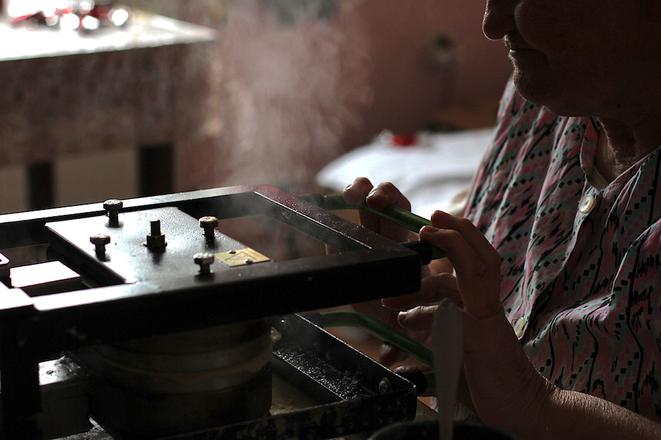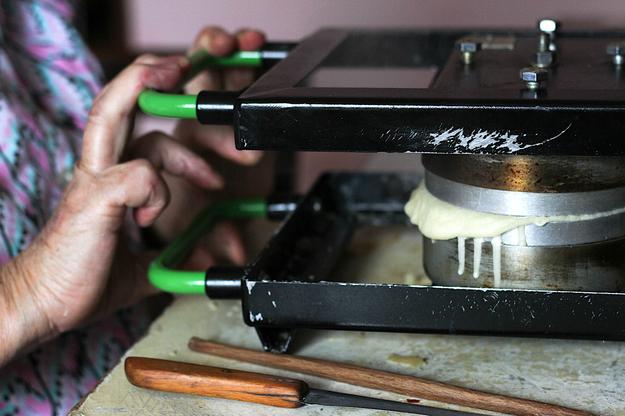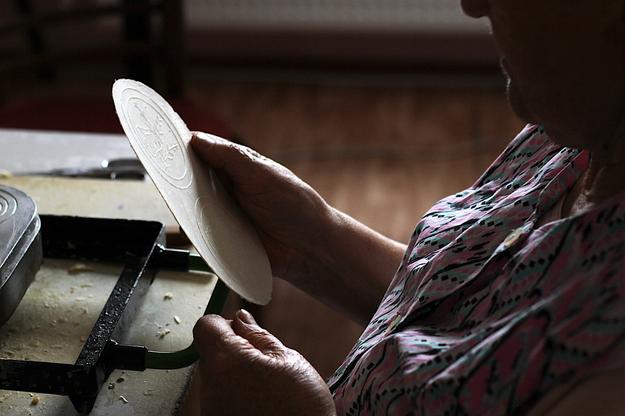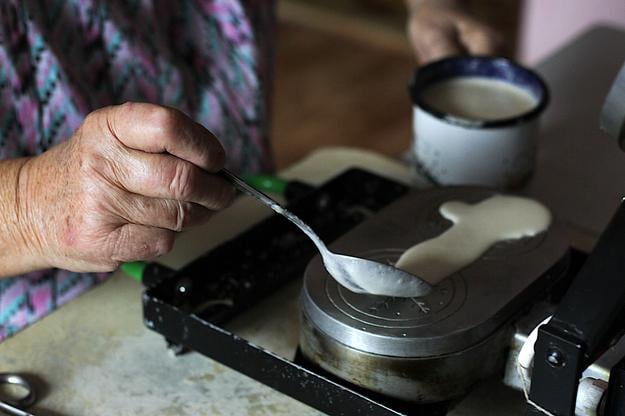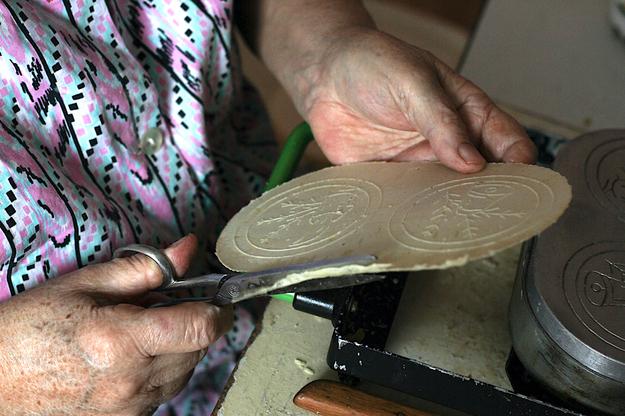As Christmas approaches, stores and markets in Slovakia start to stock bundles of thin wafers called vianočné oplátky or oblátky, depending on the region. Crisp and slightly sweet, the wafers have Christmas-themed pictures imprinted on them. There are also savoury oplátky, often with caraway seeds.
Every year a few people in our village sell them, and so I a few years ago I asked one grandma if I could come over to learn how they are made. When I come over, Pani (Mrs.) Zvonárová was finishing up the oplátky batter. She poured melted butter through a sieve and stirred a pot of flour, milk, sugar, and butter. I asked her if she has a specific recipe or if she puts it together “by eye”, as they say in Slovak. “By eye,” she said. “When I first started it was always too thick or too thin, but now I usually get it. If the batter sticks to the wafer iron, I put it in the fridge overnight and the next day it works.”
She poured a small amount of batter into a little enamel cup, stuck in a spoon, and started to shuffle to the living room, where the wafer iron was set up. She stopped on the way out of the kitchen and added water. “It’s a little thick,” she murmured.
A wood cooking stove in the kitchen radiated warmth, with a few pots containing lunch on top. I gravitated immediately to the stove; I grew up with a wood stove but didn't have one, and I missed its cosy warm dry heat. Pan (Mr.) Zvonár added a few more sticks of wood when he saw me warming my hands – even though they weren’t actually cold.
Pani Zvonárová sat down to the oplátky maker, waiting for it to warm up. Her husband sat behind her on a bed, and resumed his task of tying golden thread around salónky, chocolate candy wrapped in bright colourful foil. The threaded salónky will be hung up on the Christmas tree, where children will sneak them, leaving empty wrappers, although adults say they shouldn't be eaten until after Epiphany, January 6.
Originating in Poland, oplátky were a symbol of the Eurcharist celebrated in Roman Catholic churches. As far as I understand, the wafers in Poland are still only flour and water and rather tasteless; the wafer is passed around the table and each person breaks off a piece. In Slovakia, milk, butter, and sugar are added to the batter to make a crisper, slightly thicker, wafer. At the beginning of the Christmas Eve meal, honey is drizzled between wafers to make oplátky sandwiches.
It’s a tradition that has moved its way west fairly recently, however – as a child Pani Zvonárová had never heard of oplátky. The border between Slovakia and Poland has moved a few times, so parts of Slovakia were once part of Poland, and some traditions became shared.
She has been making them for about 10 years, selling them, as we say in English, like hot cakes. She sells as much as she makes, and is barely able to keep some back for her own family. Her son and daughter-in-law have joined her in making them.
Oplátky makers used to be flat rounds made from cast iron on the end of long handles that were held over the fire of a cook stove, with one of the stovetop rounds removed. Now they are electric – and not cheap, easily costing over 300 euro.
The first step in making oplátky is to run cloth covered beeswax quickly over the surface, to lessen the chance of the batter sticking. She then took the enamel cup and ran a soup spoon of batter across the surface, making a narrow line that spreads over the surface when the wafer maker is closed.
She pressed the top of the iron down; it hissed, steam rising and excess batter oozing out the sides. Pani Zvonárová ran the end of a pointed stick around the wafer maker to take off the extra batter. She dumped it into a container that she then gives to the dog. The dog is starting to look like a pig, she said.
The wafer iron doesn't have a temperature gauge, only on and off, so she regulated the heat as the oplátky bakes, turning it on and off as needed. When it’s done she slid a thin knife underneath to lift it off. If she missed scraping down a side, she will use scissors to even it out.
Making oplátky takes patience. If a wafer sticks badly, she has to turn off the machine, wait for it to cool down, clean the gunk from the fine lines, and try again. Sometimes a wafer is too thin or breaks as she lifts it off.
With 10 years of experience behind her, it still takes 2.5 hours to make 60 wafers, she told me. The price for homemade oplátky suddenly doesn't seem so expensive.
As the couple work alongside each other, they tell me stories from their life. They met at a communist communal dairy farm where they both worked. Even today, the farm still sends each of them a package of salónky at Christmas. Four children together, one daughter passed away young from cancer.
After about an hour the white enamel cup needed to be refilled and Pani Zvonárová’s leg had started to cramp. She hobbled around, trying to get the blood flowing again. The muscles get so tight the blood doesn’t go through, she explained, giving her leg a few bangs.
She gave me a bag of broken wafers for my children to snack on as I leave, their lunch on the wood stove now ready. The oblátky we eat on Christmas Eve will have that much more meaning now, knowing the stories of the hands that made them and the work that is involved.


